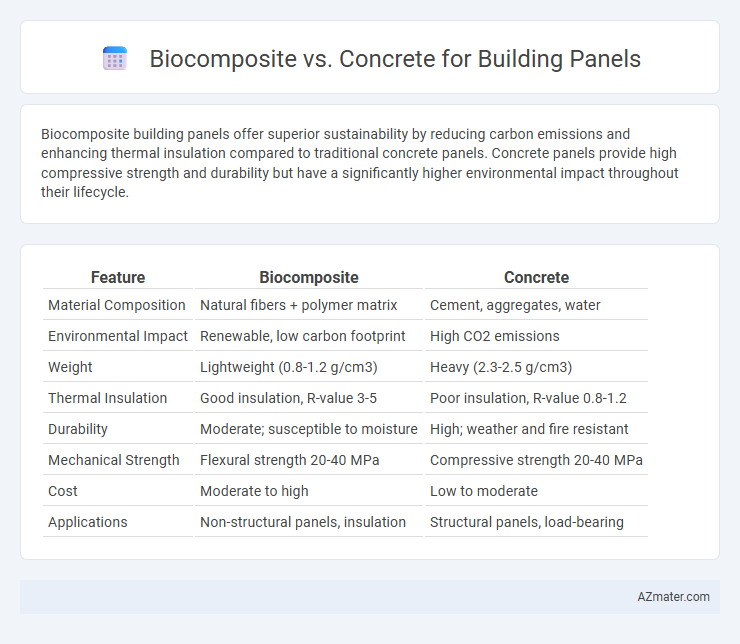Biocomposite building panels offer superior sustainability by reducing carbon emissions and enhancing thermal insulation compared to traditional concrete panels. Concrete panels provide high compressive strength and durability but have a significantly higher environmental impact throughout their lifecycle.
Table of Comparison
| Feature | Biocomposite | Concrete |
|---|---|---|
| Material Composition | Natural fibers + polymer matrix | Cement, aggregates, water |
| Environmental Impact | Renewable, low carbon footprint | High CO2 emissions |
| Weight | Lightweight (0.8-1.2 g/cm3) | Heavy (2.3-2.5 g/cm3) |
| Thermal Insulation | Good insulation, R-value 3-5 | Poor insulation, R-value 0.8-1.2 |
| Durability | Moderate; susceptible to moisture | High; weather and fire resistant |
| Mechanical Strength | Flexural strength 20-40 MPa | Compressive strength 20-40 MPa |
| Cost | Moderate to high | Low to moderate |
| Applications | Non-structural panels, insulation | Structural panels, load-bearing |
Introduction to Building Panels: Biocomposite vs Concrete
Building panels made from biocomposites offer a sustainable alternative to traditional concrete panels, combining natural fibers with resin matrices to enhance strength and reduce environmental impact. Concrete panels provide high durability, thermal mass, and fire resistance, widely used in commercial and residential construction for their load-bearing capabilities. Comparing biocomposite and concrete panels highlights differences in material weight, insulation properties, and lifecycle emissions, influencing choices in eco-friendly building design.
Material Composition: Biocomposite and Concrete Explained
Biocomposite building panels consist primarily of natural fibers--such as hemp, flax, or wood--combined with bio-based or synthetic resins, offering lightweight, sustainable alternatives with enhanced thermal insulation and lower carbon footprints compared to traditional materials. Concrete panels are composed of cement, aggregates like sand or gravel, and water, forming a dense, durable matrix renowned for its high compressive strength and fire resistance but with significant embodied energy and CO2 emissions from cement production. Understanding these material compositions highlights biocomposites' eco-friendly advantages alongside concrete's structural reliability for building panel applications.
Mechanical Strength and Structural Performance
Biocomposite building panels exhibit lower compressive and tensile strength compared to traditional concrete, limiting their use in high-load structural applications. Concrete panels offer superior durability, load-bearing capacity, and resistance to environmental stress, making them ideal for foundational and heavy-duty construction. However, biocomposites provide advantages in weight reduction, sustainability, and flexibility, which can enhance specific non-structural or lightweight panel applications.
Environmental Impact and Sustainability
Biocomposite building panels significantly reduce environmental impact by utilizing renewable natural fibers and biodegradable resins, resulting in lower carbon emissions compared to traditional concrete panels. Concrete production involves high energy consumption and substantial CO2 emissions, contributing to global warming and resource depletion. Biocomposites offer enhanced sustainability through biodegradability, reduced landfill waste, and improved lifecycle performance in eco-friendly construction applications.
Thermal Insulation and Energy Efficiency
Biocomposite building panels offer superior thermal insulation compared to traditional concrete, reducing heat transfer due to their natural fiber content and lower thermal conductivity. Enhanced energy efficiency in biocomposite panels results from better retention of indoor temperatures, leading to decreased heating and cooling demands. Concrete panels, while durable, have higher thermal mass but often require additional insulation layers to match the energy-saving performance of biocomposites.
Durability, Lifespan, and Maintenance Needs
Biocomposite building panels exhibit superior durability due to their resistance to moisture, decay, and insect damage compared to traditional concrete panels, which are prone to cracking and corrosion over time. The lifespan of biocomposite panels typically exceeds 30 years with minimal degradation, whereas concrete panels often require repairs or replacements after 20-25 years due to structural wear and environmental impacts. Maintenance needs for biocomposite panels are significantly lower, involving occasional cleaning and inspection, while concrete panels demand regular sealing, crack repairs, and protection against spalling to maintain integrity.
Cost Analysis and Economic Considerations
Biocomposite building panels typically offer lower material and manufacturing costs compared to traditional concrete panels due to renewable raw materials and simpler production processes. Concrete panels involve higher expenses related to raw material extraction, energy-intensive curing, and transportation weight, impacting overall project budgets and logistics. Long-term economic considerations also favor biocomposites through reduced maintenance costs and enhanced sustainability incentives, boosting their cost-effectiveness in green construction projects.
Design Flexibility and Architectural Applications
Biocomposite building panels offer superior design flexibility compared to concrete due to their lightweight nature and ease of molding into complex shapes, enabling innovative architectural forms and customized textures. Concrete panels, while providing high structural strength and durability, are limited in intricate design possibilities because of their rigidity and heavier weight. The enhanced adaptability of biocomposites supports sustainable architecture trends by allowing seamless integration of organic aesthetics and functional features in diverse building applications.
Health and Indoor Air Quality Benefits
Biocomposite building panels offer superior health benefits compared to traditional concrete by minimizing harmful chemical emissions and enhancing indoor air quality through the use of natural fibers and non-toxic binders. These panels reduce volatile organic compounds (VOCs) and allergens, creating a healthier living environment and lowering risks of respiratory issues. In contrast, concrete panels often emit dust and contain additives that may compromise air quality, making biocomposites a preferable choice for sustainable and health-conscious construction.
Future Trends and Innovations in Building Panels
Biocomposite building panels are gaining traction due to their sustainability, lightweight properties, and superior thermal insulation compared to traditional concrete panels. Innovations in biocomposite materials involve the integration of natural fibers, bio-resins, and nanomaterials to enhance durability, fire resistance, and moisture control. Future trends emphasize the adoption of eco-friendly production processes and the development of hybrid panels combining biocomposites with recycled concrete to optimize structural performance and environmental impact.

Infographic: Biocomposite vs Concrete for Building Panel
 azmater.com
azmater.com